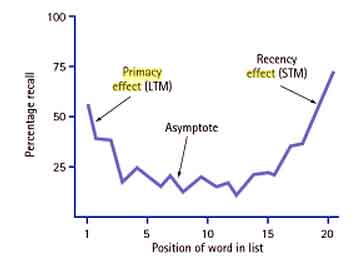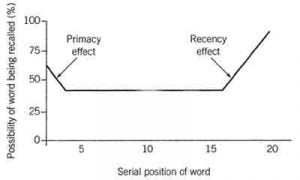Some of the strongest evidence for the multi-store model (Atkinson & Shiffrin, 1968) comes from serial position effect studies and studies of brain-damaged patients.
The serial position effect is the tendency to remember the first and last items in a series better than those in the middle. It is a form of cognitive bias that is thought to be due to how information is processed and stored in memory.
The tendency to recall earlier words is called the primacy effect; the tendency to recall later words is called the recency effect.
Murdock (1962)
Procedure
Murdock presented participants with lists of 10 to 40 words, one word at a time, at a rate of one word per second. After the list was finished, participants were asked to recall as many words as they could in any order.
Results
He found that the probability of recalling any word depended on its position in the list (its serial position).
Words presented either early in the list (the primacy effect) or at the end of the list (the recency effect) were more often recalled, but the ones in the middle were more often forgotten.

The improved recall of words at the beginning of the list is called the primacy effect; that at the end of the list, the recency effect. This recency effect exists even when the list is lengthened to 40 words.
Conclusion
Murdock suggested that words early in the list were put into long term memory (primacy effect) because the person has time to rehearse each word acoustically.
Words from the end of the list went into short term memory (recency effect) which can typically hold about 7 items.
Words in the middle of the list had been there too long to be held in short term memory (STM) (due to displacement) and not long enough to be put into long term memory (LTM). This is referred as a asymptote.
In a nutshell, when participants remember primary and recent information, it is thought that they are recalling information from two separate stores (STM and LTM).
Glanzer and Cunitz (1966)
Procedure
The procedure for the Glanzer and Cunitz (1966) study was as follows:
- Participants were randomly assigned to one of two groups: immediate recall or delayed recall.
- Both groups were presented with a list of 12 monosyllabic words, one word at a time, at a rate of one word per second.
- The immediate recall group was asked to recall the words as soon as the list was finished.
- The delayed recall group was asked to count backward by threes for 30 seconds (the Brown-Peterson technique) before being asked to recall the words.
- Participants were instructed to recall the words in any order.
The researchers recorded the number of words that each participant recalled correctly.
Results
The results showed that the immediate recall group recalled significantly more words at the beginning and end of the list than the words in the middle. This is known as the primacy and recency effects, respectively.
The delayed recall group also showed a primacy effect, but the recency effect disappeared.
This suggests that the recency effect is due to the words still being in short-term memory at the time of recall, while the primacy effect is due to the words being transferred to long-term memory.

Conclusion
The words at the end of the list are only remembered if recalled first and tested immediately. Delaying recall by 30 seconds prevented the recency effect.
The study has important implications for understanding how memory works and developing strategies for improving memory.
For example, if you are trying to remember a list of items, repeating the items at the beginning and end of the list more often is helpful. Additionally, if you have a delay between learning and recalling the items, it is helpful to rehearse them during the delay.
References
Atkinson, R. C., & Shiffrin, R. M. (1968). Chapter: Human memory: A proposed system and its control processes. In Spence, K. W., & Spence, J. T. The psychology of learning and motivation (Volume 2). New York: Academic Press. pp. 89–195.
Glanzer, M., & Cunitz, A. R. (1966). Two storage mechanisms in free recall. Journal of Verbal Learning and Verbal behavior, 5(4), 351-360.
Murdock, B. B. (1962). The serial position effect of free recall. Journal of Experimental Psychology, 64(5), 482–488.

